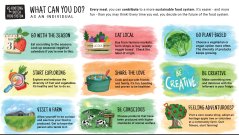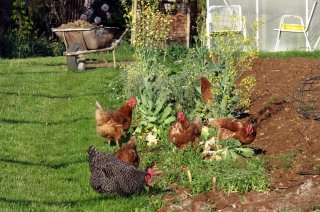
Longread
Re-rooting the Dutch food system: from more to better
What does a regenerative and nourishing food system in 2050 look like? This was the challenge for those participating in the Food Systems Vision Prize launched by the Rockefeller Foundation. Here, a team of farmers, representatives of nature and agricultural organizations and scientists of Wageningen University & Research, led by Imke de Boer (Professor of Animal Production Systems) and Evelien de Olde (researcher Animal Production Systems), present their food vision for their area of choice ‘the Netherlands’, and identified which changes are needed to get there.
The team:
Imke de Boer (WUR), Evelien de Olde (WUR), Ruud Zanders (Kipster), Annechien ten Have-Mellema (Hamletz), Jeroen Candel (WUR), Boy Griffioen (De Groene Griffioen), Kawire Gosselink (WUR), Annette Harberink (Keizersrande), Klarien Klingen (de Wilde Peen), Joris Lohman (Food Hub), Katrien Termeer (WUR), Frits van der Schans (CLM), Geert van der Veer (Herenboeren), Piet van IJzendoorn (Zonnehoeve)
Read their vision in this longread.
‘Our inclusive food vision is based on healthy agroecosystems and the resources they provide, and is rooted in local socio-economic conditions’, says Imke de Boer. ‘It comprises a journey through six unique regions in the Netherlands, which differ widely in agroecological and socioeconomic conditions, and describes how our ideal food system will look by 2050 in each region of the country.’
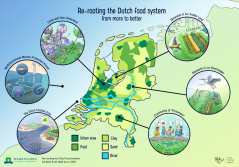
1. Stewards of our Arable Land
The journey begins in the province of Flevoland, a region that combines the functions of food crop production, nature conservation and sustainable living. Reflecting the fact that healthy soil is one of the fundaments of our future food system, here we find stewards of arable land (see visual below: Stewards of our Arable Land) who are growing crops for direct human consumption. Intercropping activities such as strip or mosaic cropping and agroforestry have become the norm as they make the most of valuable soil and promote biodiversity. Growing multiple robust crops on the same field at the same time results in higher yields and more effective use of nutrients than sole crops, and reduces the spread of diseases and pests. Legumes are a key functional group in these intercropping systems. The increase in root surface area and diversity under intercropping in combination with a healthy soil life plays a key role in the availability and transfer of soil nutrients to plants as well as in plant health and soil fertility.
Biodiversity thrives
To protect valuable lifeforms in the soil and above (e.g. pollinators), pesticides and herbicides are no longer used, and agricultural lands are surrounded by structurally characteristic patches of native vegetation. This has allowed biodiversity to thrive, not only on specific nature areas but also in the nature-inclusive areas focused on food production. We envision genuine diversity in soil life, plant and animal species, as well as in farming systems and landscapes. Such diversity on multiple scales is providing a wide variety of ecosystem services, including nutrient cycling, water buffering and purification, carbon storage and the provision of biodiversity and habitat functions. It is also enhancing the resilience of our food system to shocks and stresses such as climate and pests.
Supporting nature with technology
By 2050 technology is being used to work with nature and support regenerative farming practices. Our stewards skilfully deploy small-scale robots to monitor, weed and harvest the multiple crops on their arable land. It is impressive to see how they combine drone-recorded images of crop fields with soil scans to better support crop growth with nutrient requirements, minimising losses of nutrients to the air, water and soil in the process.
Plant biomass as primary food source
Note, too, the way that fertile arable land is no longer used to produce feed crops for animals. Although this approach may have boosted the production of animal-based food in the past, it is now considered unethical for the way it competes with the production of plant biomass for direct human consumption. Plant biomass is the primary source of food for humans. To get the best out of plant-based ingredients, Dutch chefs regularly organise on-farm cooking events for the local community.
Food waste will have decreased by 80% and we will be utilising valuable nutrients in human excreta to fertilise soils.
On average, Dutch citizens in 2050 consume about two thirds of their proteins from plants and one third from animal-based foods. While this diet is far better for people and planet, the production and consumption of plant-based foods does result in by-products such as crop residues, co-products from industrial food processing, food losses and waste and human excreta. Making bread, for example, produces straw and husks (crop residues from cereal production), wheat middlings (a co-product of flour production), food waste and human excreta.
A key priority that will have been achieved by 2050 is that by-products edible by humans, such as wheat middlings and food waste, are greatly reduced – for instance, the production of middlings is avoided by making wholegrain instead of white bread. Food waste will also have decreased by 80% and we will be utilising valuable nutrients in human excreta to fertilise soils. By-products that cannot be prevented, eaten by humans or are not needed to restore or conserve soil fertility are given to farm animals (including farmed fish or insects), who can convert them into valuable food and manure. A circular food system will be the new paradigm as valuable nutrients are recycled from soil, water and the atmosphere into living organisms and back, and across farms and regions.
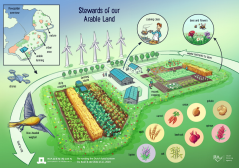
2. Cities and their Hinterland
This 2050 vision implies that nutrients in plant-based foods are being transported from Flevoland (see 1: Stewards of our Arable Land) to nearby cities like Amsterdam (see visual below: Cities and their Hinterland), while valuable nutrients in human excreta are returned to the land. Such regional cycles of nutrients are key: despite the newly established urban farming activities in and around urban areas such as roof-top farming, vegetable gardens and agroforestry, densely populated urban areas still depend on their hinterland for food supplies.
Green cities
That said, farming in and around densely populated urban areas also has essential social benefits. It may only involve a little space on a rooftop, a patch of vegetables, a few pots of herbs on a balcony, a tiny edible green wall, an afternoon spent harvesting in a nearby agroforestry or a bike-ride to a local dairy farmer to buy cheese and enjoy the landscape with its meadow birds, but all these experiences have considerable value. They increase consumer awareness and education about seasonal food production, promote the connection between consumers, producers and nature, and contribute to community building and a healthy and enjoyable life. Our green cities with street trees, urban parks, edible green walls and community and rooftop gardens also keep us cool amid rising temperatures and contribute to a more fluid architecture-landscape surface.
Recycling nutrients
Despite all the urban agriculture, however, cities will remain hotspots in terms of nutrient cycling. Nutrients are imported through food and exported through human excreta and unavoidable food waste. At present, most of the phosphorus in our food system, for instance, is lost as we allow human excreta be wasted. This leaves us dependent on finite phosphate rock, which is unsustainable. Nutrient outflows from cities will need to be recycled to the hinterland to fertilise soils or feed farm animals.
Consumer cooperatives will have heavily invested in waste separation systems.
By 2050, we will have recognised human excreta as a valuable resource rather than a waste, and neighbourhoods all over the country will have installed smart toilets that save water and/or separate urine and faeces. Technologies such as ammonia stripping, struvite precipitation and biological decomposition techniques will be applied to safely recover nutrients from human waste. Households will no longer use drinking water to flush their toilets, but will use rainwater or smart water management systems that will recycle up to 95% of their shower and bathwater for toilet flushing, washing machines or gardening.
To maximise the recycling of unavoidable household waste, consumer cooperatives will have heavily invested in waste separation systems, yielding separate flows of plant-based and animal-contaminated food waste to increase recycling potential. While plant-based food waste can be immediately fed to farm animals, animal-contaminated food waste will first be heat treated to deactivate potential diseases before being fed to pigs, poultry, fish and insects only.
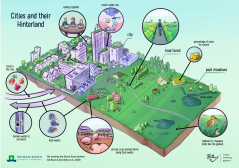
In 2050, farm animals, including farmed fish and insects, are only fed by-products that are unavoidable and inedible to humans, including food waste and grass resources. By returning nutrients in these by-products into the food system, farm animals play a crucial role in feeding humans without using additional resources. Pigs consume unavoidable food waste from cities as they eat most foods which are also consumed by humans. Laying hens and farmed fish feed on high-quality unavoidable by-products originating in food processing, such as bakery waste, offal and insects raised on manure. Ruminants consume grass from herb-rich grasslands.
Alternative uses of grassland
By 2050, not all biomass from grassland will be available as feed for ruminants as this precludes alternative uses like rewilding or agroforestry, which are often preferable in terms of biodiversity and climate change. Some Dutch grasslands have therefore been transformed into wetlands or forest to sequester carbon and combat climate change. Groundwater levels in our peatlands have been raised, reducing grass productivity but improving carbon storage and natural habitats for meadow birds like the godwit. Three decades from now dairy farmers in these areas have adopted breeds with relatively lower body weights, such as Jersey cows (see 2: Cities and the Hinterland). These ruminants not only produce milk, meat and dairy, but also have a clear role in the conservation of nature and landscape. Farm income therefore comes from combining milk & meat production with nature & landscape conservation. Dairy farmers on peatlands earn their income by directly selling dairy and meat products in farm shops or to nearby cities while contributing to the conservation of peat landscapes.
We halved our consumption of food from animal sources compared to 2020.
Farm animals can contribute to a circular food system
The number of farm animals kept in 2050, however, will be lower than in 2020. By 2050, this figure – and, hence, the production and consumption of animal-based food – is determined by the availability of by-products which are inedible to humans, grass resources and the carrying capacity of our ecosystems. Initial estimates show that a sustainable system of this kind can provide up to one third of people’s daily protein needs. Farm animals will contribute to a circular food system by recycling biomass nutrients that are inedible for humans back into the food system. This also implies that we will have halved our consumption of food from animal sources compared to 2020. Animal-based foods will be a smaller but more highly appreciated part of our meal (for non-vegetarians at least).
Animal farming with care
This will also be an era in which people are taking full responsibility for farm animals, assuring the welfare of each animal kept in the Netherlands. Housing systems have been adapted to animals instead of ignoring their needs, ensuring that they are healthy, comfortable and able to express their species-specific behavioural needs. This means that all animals have access to adequate and appropriate food and drink, live in a comfortable climate, have a safe and comfortable place to rest, live socially in stable groups, have the opportunity to synchronise their behaviour with conspecifics, and can forage or explore. Ruminants are able to graze, pigs to root and hens to scratch and dust bathe. Non-invasive sensors monitor the health, behaviour and mental state of individual farm animals to improve and ensure their wellbeing.
A healthy, sustainable and diverse diet
As well as significantly reducing our consumption of animal products, by 2050 we will also have increased the diversity of food products consumed. People who still eat animal-based food are aware that it is unethical to not utilise every part of an animal, from the brain to the hides. Our circular chefs have taught us how to again enjoy nose-to-tail eating, and their recipes seduce us to consume previously less favoured but sustainable products, such as insects, sea kale, New Zealand spinach and salsify. A larger number of consumers prefer for ethical reasons not to consume any animal products. They know how to plan their diets appropriately and use supplements and fortified food when needed to avoid any nutrient deficiencies.
By changing our food environment, healthy and sustainable food has been made appealing, normal and easy.
The majority of our 2050 consumers eat healthy and sustainably, especially because we have changed our food environment. Healthy and sustainable food is appealing, normal and easy. Consumers know that plant-based food is delicious and affordable, which in turn makes it attractive. Delicious vegan and vegetarian foods are the default in supermarkets, restaurants, catered events and school & university canteens. Moreover, consumers enjoy being encouraged to make the right food choices thanks to simple and widely promoted mottos like ‘Meat on Mondays’, ‘Red Meat is a Treat’, ‘Fish on Fridays’, ‘Fruits Frequently’ or ‘Beans not Beef’.
People get support in more sustainable planning and cooking from influencers and prominent chefs online who have developed delicious recipes that also happen to be circular and sustainable. Consumers use a ‘healthy and sustainable’ filter on their shopping apps, and happily opt into personalised tips and recommended substitutions. These apps and bespoke tips also provide easy advice on how to avoid the consumption of snacks and empty calories. This message is backed up by the fact that government has banned commercials for snacks, soft drinks and other foods and drinks containing mostly empty calories. When the world sings, it’s certainly no longer about cola.
By 2050 people will have rediscovered and embraced the habit of gathering around the dinner table, taking time out to reflect and enjoy good conversation. They also have a renewed pleasure in and appreciation for food, eat healthier meals and welcome a more active lifestyle. Advances in blockchain technology help people track the entire journey of their food and have revolutionised systems of certification and traceability. Citizens are consequentially more involved in food production and have a greater awareness of how food is produced. Celebrating the diversity of regional products, they are willing to pay a fair price for what they eat.
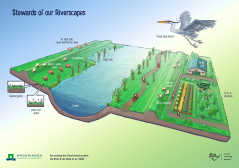
3. Stewards of our Riverscapes
To protect the low-lying delta of the Netherlands against floods, we will have significantly extended the floodplains along our main rivers. Ruminants now play an important role in healthy and regenerative food systems along these rivers. Riverscape stewards, such as those along the IJssel, keep the traditional Meuse Rhine IJssel cattle breed for flood prevention and landscape preservation as well as food production (see visual above: Stewards of our Riverscapes). To protect against floods, the government pays farmers to graze their cows on the extended river floodplains to keep the grass short, facilitating flooding in case of higher water levels. This also helps conserve the beautiful landscape, made accessible to people who wish to hike and enjoy nature. In addition to having prioritised the production, consumption and fair distribution of high-quality food over quantity, society has recognised the importance of ensuring biodiversity and landscape conservation via ecosystem services like flood prevention.
4. The Dutch Coastal Area
As well as increasing the need for water buffering and storage, higher temperatures also cause a rise in sea levels. By 2050, much of the agricultural land behind the Dutch coast will be affected by salinisation (see visual below: The Dutch Coastal Area). In these regions, land stewards intercrop salt-tolerant and robust plant species such as sea kale, samphire and red beets. In addition to food production on land, humans harvest food from fresh and saltwater bodies.

A second fundament of our healthy and regenerative food system is a healthy aquatic ecosystem. Aquatic foods will be harvested and consumed across all trophic levels and aquatic ecosystems (not only carnivorous fish, like salmon), each in proportion to its natural productivity. In 2050 edible seafood is prioritised for human consumption, with farmed fish only being fed by-products from slaughter and the processing of aquatic organisms that are inedible to humans. Along the Dutch coast, integrated multi-trophic aquaculture systems combine the cultivation of mussels, seaweeds, worms and crabs, among others. These integrated aquaculture systems help us recycle inevitable nutrient losses from agricultural land back into the food system. The availability of nutrients determines the boundaries for these integrated aquaculture systems.
5. Multifunctional Marine Protected Areas
This will be a period when we are also generating wind energy in marine protected areas. Deploying complex concrete structures in protected areas in-between wind turbines has re-established the biodiversity in these aquatic environments and regenerated natural habitats for benthic bivalves, crustaceans and reef-associated fish in particular (see visual below: Multifunctional Marine Protected Areas). Fossil fuels are no longer used as we get all our energy directly from the sun, wind, running water or geothermal power generated and stored in the earth. Biomass is prioritised for food production and other basic human needs, such as clothing and housing (wooden houses and furniture). Solar panels are the default on rooftops unless they are used for food production or greening the city.

6. Community of 'Prosumers'
In addition to the way we produce and consume food, the governance of food systems has also changed and become more democratic by 2050. Citizens organise themselves in new ways, establishing forms of energy and food democracy by participating in food policy councils to make collective decisions about their local food environments. At the national level, a National Food Assembly will advise Parliament and the newly established Ministry of Food & Health on policy changes that may further foster the food system’s sustainability and health outcomes.
Citizens become shareholders who actively co-decide about the future of food production.
These newly established food democracy initiatives will be complemented with new forms of ownership in food chains. The dichotomy between producers and consumers will be overcome, as citizens become shareholders who actively co-decide about the future of food production. Various forms of farming communities will ensure that consumers and producers collaboratively shape the way their food is produced.
An increasing number of citizens will have joined community-supported agriculture, by buying a share in a farm and receiving a share of the harvest in return. In these farming communities about 200 families are stakeholders in a farm and employ a farmer to take care of their food production. In collaboration with the farmer, they decide which crops to grow and which animals to keep, and share the risks involved in the production of food from weather conditions, diseases and pests, which are no longer borne solely by the producer. They therefore call themselves ‘prosumers’ (i.e. combination of producer and consumers; see visual below: Community of ‘Prosumers’).
Some families even live around the farm and share electric cars and other facilities. Adults and children in these communities are conscious consumers who are highly aware of how their food is produced, produce less waste and eat more healthy food. This type of farming also allows them to spend time at the farm with family and friends. All the experiences combine to generate a new respect for the lives of people, animals and the planet (including materials).

Social foundations defined by the government
These mechanisms will be promoted within the social foundations defined by Dutch politicians together with their EU colleagues, and include essential rights for humans (the right to food, food safety standards and fair working conditions and wages) and animals (health, wellbeing and the possibility to express species-specific behaviour). Together with the environmental ceilings which prevent too great a strain being collectively placed on the environment, these social boundaries define a safe-and-just operating space in which human, animal and planetary well-being are assured.
Knowing this operating space and associated long-term policy goals provides clarity to food stakeholders and enables them to make informed decisions and meaningful investments. Recognition of the boundaries of our operating space and a reconnection with the experiences related to food production has replaced excessive consumption and waste of food and materials with more conscious consumption. Moreover, those material goods which are still consumed have passports to allow materials to be replaced when needed, or reused for other purposes. Similarly, farm buildings and machinery have become modular, allowing for flexibility and reuse. It is no longer necessary to mine valuable resources such as metals.
A fundamental shift
What started in 2020 with a few radical ideas among food system actors has, by 2050, resulted in a fundamental shift of our food system to one that is healthy and regenerative (see visual below: Key objectives for food systems change).
Moving our food system from providing higher quantity to better quality is beneficial for people, animals and the planet.
This system will no longer be governed by the free market but by all food system stakeholders operating within the safe-and-just operating space and based on an inclusive market system which recognises the value of public goods such as fresh air, clean water, healthy soil and diversity of species and landscapes. By 2050, we will have adopted a richer range of indicators to express what is valuable to our society and planet. Our vision of a ‘national societal product’ reflects the contribution of food system and ecosystem services to society more fully than gross domestic product (GDP). It clearly illustrates how moving our food system from providing higher quantity to better quality is beneficial for people, animals and the planet as a whole.
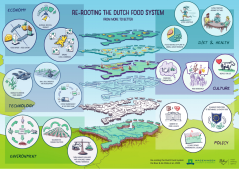
A joint effort
To transition our food system towards this safe-and-just operating space, the Dutch government will have realised several key milestones by 2050. It will have adopted an explicit and elaborate national food strategy with which all sectoral policy efforts will be aligned. Local governments will also play a key role, by shaping healthy food environments, stimulating innovative practices, strengthening food democracy and organising educational activities. Cross-border challenges will be tackled at EU and global levels, and established institutions will be transformed to allow for more effective and inclusive decision-making. We will also have established a new level of accountability and an advanced form of social corporate responsibility.
Such a fundamental shift will not be possible without the energy and spirit of many food system stakeholders.
Moving the food system towards this future will require action by a broad range of stakeholders, such as farmers, the food industry, retailers, financial organisations and consumers. While many market and civil society initiatives will play a crucial role in achieving our vision, the government will have taken its responsibility by having the courage to define the safe-and-just operating space for human activities, including the food system. We will produce and eat our food within the planetary boundaries of the food system and respect the essential rights of humans and animals.
Imke de Boer: ‘Such a fundamental shift in our food system will not be possible without the energy and spirit of many food system stakeholders. By connecting to our roots – our healthy agroecosystems, and our capacity to collaborate – we will have collectively realised a healthy and regenerative food system in the Netherlands.’
Vote with your fork
Consumers also have a role to play. Buy and eat local products more often. Use up food leftovers, don't waste food. Don't eat meat for a change and try plant-based products such as plant-based dairy products or meat substitutes. And eat together, because then you cook healthier. These are De Boer's tips. "These are things you can do yourself, every day. Vote with your fork."
